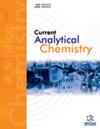Label-free Electrochemical Nanobiosensors using Au-SPE for COVID-19 Detection: A Comparative Review of Different Biomarkers and Recognition Elements
IF 1.7
4区 化学
Q3 CHEMISTRY, ANALYTICAL
引用次数: 0
Abstract
An immediate and precise diagnosis is required due to the COVID-19 outbreak. Labelfree electrochemical biosensors show promise as potentially valuable instruments for detecting COVID-19. These biosensors are distinguished by their lack of complexity, high speed, sensitivity, and relatively low cost. The precise COVID-19 biomarkers may be recognized without labeling or amplification by detecting the electrical signal created by direct contact between the target analyte and the identification element positioned on the electrode surface. This can be done by placing the electrode in contact with the target analyte, which will amplify the signal. It has been shown that using gold screen printed electrodes, also known as Au SPE, is beneficial when used as an electrode material in label-free electrochemical biosensors. This review study examines and contrasts the performance of several label-free electrochemical biosensors that use Au SPE to detect COVID-19. The merits and limitations of each biosensor will also be discussed. These biosensors use recognition components like DNA, RNA, antibody, aptamer, and MIP and depend on various indicators, such as viral RNA, viral protein, and host antibody. In addition, an analysis of the difficulties and possibilities that may present within this burgeoning subject is carried out. This includes the enhancement of sensor selectivity and stability, optimizing sensor manufacture and design, integrating the sensor with portable readout equipment, and validating the sensor's effectiveness via the use of genuine clinical samples. It can be reasoned out that label-free electrochemical biosensors that make use of gold screen-printed electrodes (Au SPE) have a significant amount of potential for the detection of COVID-19. However, further study is required to address various difficulties, improve their dependability, and broaden the range of applications for these technologies.使用 Au-SPE 检测 COVID-19 的无标记电化学纳米生物传感器:不同生物标记物和识别元素的比较综述
由于 COVID-19 的爆发,需要立即进行精确诊断。无实验室电化学生物传感器有望成为检测 COVID-19 的重要仪器。这些生物传感器的特点是不复杂、速度快、灵敏度高且成本相对较低。通过检测目标分析物与电极表面上的识别元件直接接触产生的电信号,无需标记或放大即可识别出精确的 COVID-19 生物标记物。将电极与目标分析物接触可放大信号。有研究表明,在无标记电化学生物传感器中使用金丝网印刷电极(也称为 Au SPE)作为电极材料是有益的。本综述研究考察并对比了几种使用金丝网印刷电极检测 COVID-19 的无标记电化学生物传感器的性能。同时还将讨论每种生物传感器的优点和局限性。这些生物传感器使用 DNA、RNA、抗体、aptamer 和 MIP 等识别元件,并依赖于各种指示剂,如病毒 RNA、病毒蛋白和宿主抗体。此外,还分析了这一新兴学科可能存在的困难和可能性。这包括提高传感器的选择性和稳定性,优化传感器的制造和设计,将传感器与便携式读出设备集成,以及通过使用真正的临床样本验证传感器的有效性。可以推断,利用金丝网印刷电极(Au SPE)的无标记电化学生物传感器在检测 COVID-19 方面具有很大的潜力。然而,要解决各种困难、提高其可靠性并扩大这些技术的应用范围,还需要进一步的研究。
本文章由计算机程序翻译,如有差异,请以英文原文为准。
求助全文
约1分钟内获得全文
求助全文
来源期刊

Current Analytical Chemistry
化学-分析化学
CiteScore
4.10
自引率
0.00%
发文量
90
审稿时长
9 months
期刊介绍:
Current Analytical Chemistry publishes full-length/mini reviews and original research articles on the most recent advances in analytical chemistry. All aspects of the field are represented, including analytical methodology, techniques, and instrumentation in both fundamental and applied research topics of interest to the broad readership of the journal. Current Analytical Chemistry strives to serve as an authoritative source of information in analytical chemistry and in related applications such as biochemical analysis, pharmaceutical research, quantitative biological imaging, novel sensors, and nanotechnology.
 求助内容:
求助内容: 应助结果提醒方式:
应助结果提醒方式:


